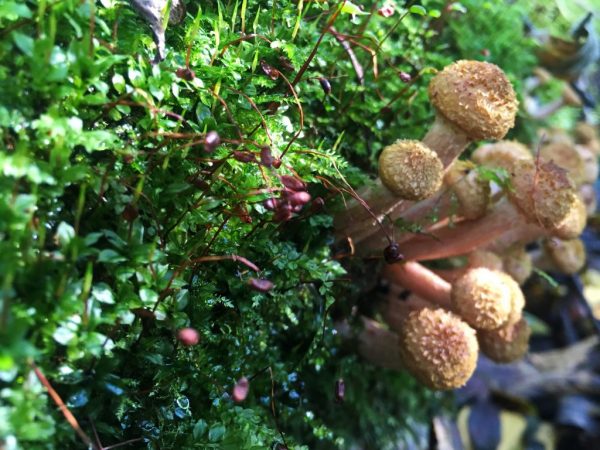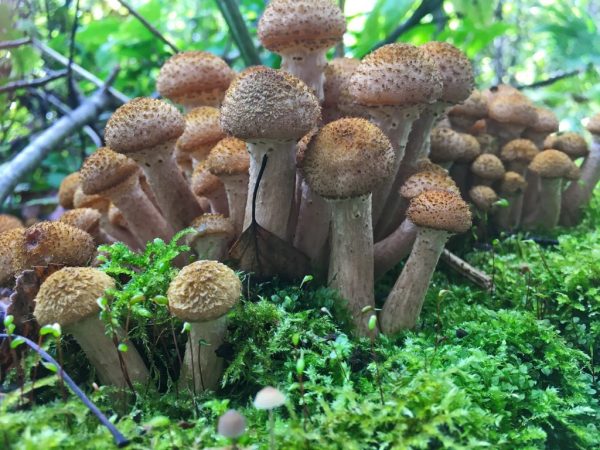Summer mushrooms: description, dangerous doubles
Honey mushrooms are appreciated for their taste and versatility. The problem is that they have dangerous counterparts. The most poisonous is the false summer mushroom. Insidious false snakes are similar to their edible counterparts, so there are frequent cases of poisoning among those who like to eat mushrooms. To prevent this from happening, the mushroom picker must necessarily distinguish between the types of poisonous twins.

Summer mushrooms
Description of summer mushroom
Summer honey agaric is harvested in deciduous and mixed forests. Prefers deciduous tree species or their rotten wood as a substrate. The species grows in whole families on dead wood or stumps. Harvesting takes place from mid-April to November.
The description of the view is as follows:
- Hat size: in the mushroom of this species it reaches 6-7 cm. In young mushrooms it has a neat convex shape, and in old mushrooms it acquires a flat shape with a small tubercle at the top.
- Hat color: depends on the humidity level. If the forest is dry, the mushrooms will have a matte golden yellow color, small grooves along the edge of the cap. If it is humid in the forest, the mushrooms will have a brown or ocher hue, slightly shine through in the light.
- Head surface: slightly slimy to the touch, smooth, moist.
- Hymenophore: lamellar. There is a white or yellowish ring under the cap on the leg; scales are located below the ring. The plates are firmly attached to the cap.
- Disputes: the color is dark with a brown tint.
- Leg: strong, thin, grows up to 7 cm.
- Pulp: thin, dry at the stalk, fibrous, watery at the cap.
- Smell: when broken, the mushroom has a pleasant woody smell.
Beneficial features
Summer mushrooms are a storehouse of useful substances. The nutritional value of summer mushrooms in terms of 100 g of substance is presented:
- water - 90 g;
- proteins - 2.2 g;
- fats - 1.2 g;
- carbohydrates (mono- and disaccharides) - 0.5 g;
- dietary fiber - 5.1 g;
- ash elements - 0.5 g.
The vitamin composition is represented by the following complex:
- E (tocopherol) - 0.1 mg;
- C (ascorbic acid) - 11 mg;
- B2 (riboflavin) - 0.4 mg;
- B3 (PP, niacin) 10.7 mg.
Also, the composition of mushrooms contains valuable micro-macroelements:
- Potassium - 400 mg;
- Phosphorus - 45 mg;
- Magnesium - 20 mg;
- Calcium - 5 mg;
- Sodium - 5 mg;
- Iron - 0.8 mg
By the content of calcium and phosphorus, mushrooms are not inferior to fish.
The fungus has an antibacterial effect, preparations based on it successfully treat a number of bacterial diseases. The special properties of this mushroom make it possible to treat staphylococcus aureus.
They contain polysaccharides, substances that prevent cancer cells from multiplying.
In addition to the above, regular consumption of mushrooms contributes to:
- normalization of the heart;
- improving performance;
- increased immunity;
- lower cholesterol levels;
- elimination of intestinal infections;
- elimination of constipation;
- elimination of stress;
- improving memory;
- resorption of blood clots.
Harm and contraindications

Mushrooms are contraindicated in diseases of the stomach
Honey mushroom will not harm if you choose high-quality and edible fruits. But there are still contraindications:
- These mushrooms should not be given to children under 7 years old (then - to a limited extent): the children's stomach is not able to digest mushrooms at all.
- They are contraindicated in people with serious diseases of the stomach and intestines.
- Renal failure
- People with pathologies of the heart, hypertension.
Unfortunately, honey mushrooms are able to accumulate salts of heavy metals in their fruit bodies.
Dangerous doubles
The summer honey agaric has dangerous twins, so poisonous that they can be fatal.
Sulfur-yellow lodge
The sulfur-yellow false honey is the most dangerous false brother of the edible mushroom, it is also called the false summer honey. In the central part of Russia, a false summer mushroom will have a red-brown hat, in the south - a sulfur-yellow one. The cap of young mushrooms is convex, in adults it straightens a little. The edges of the cap are yellow-green. The remains of the bedspread can hang from them (from the bottom side). The lamellar hymenophore of young fungi is sulfur-yellow, of adults it is gray-violet. The stem is thin, without the ring typical of edible mushrooms.
According to the description, the pulp of the mushroom, when broken, has a sulfur-yellow color. The mushroom tastes bitter with an unpleasant odor.
Galerina bordered
Galerina bordered is similar to edible mushrooms, but it has a number of differences:
- the cap of the bordered gallery has a red color with a transition to yellow at the edges;
- the bell-shaped cap of young mushrooms opens to form an almost flat surface;
- a leg with a ring, but without scales;
- the flesh is thin, yellow-brown;
- when breaking, the mushroom has a mealy smell;
- does not form intergrowths.
Irina Selyutina (Biologist):
Of course, the bordered gallery is dangerous, and in order not to become its victim, let's clarify some more structural features:
- The hat is hygrophilous, i.e. due to the peculiarities of its structure, it is able to retain a certain amount of water in itself. At the same time, in wet weather, concentric zones appear on the surface.
- The plates change color from yellowish to ocher and reddish-brown.
- The hymenophore is closed with a dense and thick white ring (it is clearly visible).
- Spores and spore powder: rusty brown.
- On the peduncle, a rather dense membrane ring is visible in young specimens, which can disappear with age.
- The color of the leg in the lower part corresponds to the color of the cap, and in the upper (above the ring) the leg is covered with a mealy bloom.
In the fruiting body of the bordered gallerina, the same amatoxins were found as in the pale toadstool.
Galerina chooses coniferous forests for growth, where he acts as a wood-destroying fungus. Did you know? Sometimes the mycelium of the bordered gallerina settles on rotting underground roots (any underground wood) and then, the fruiting bodies coming out to the surface, create the illusion of fungus growth on the soil.
Fake Foam Brick Red
The Latin name of the genus Hypholoma is also used in the Russian-language version of the specific name, in this case the mushroom is called brick-red Gifoloma. As the name suggests, the mushroom has an orange, almost red color, reminiscent of the color of fired brick. There is no ring characteristic of this species on the leg. The pulp is light yellow, bitter.
Irina Selyutina (Biologist):
In young mushrooms, gray plates, as the fruit body ripens and ages, acquire a brown or yellowish-olive tint.
The brick red pseudofoam cap is usually darker in the center than the rest. In addition, white flakes from the private velum (bedspread) can also be seen around the edges of the cap. The pulp is slightly bitter in taste, colored in a dirty or light yellow color.
The leg can reach a length of 10 cm and be 1.5 cm in diameter. In its upper part (above the remains of the bedspread, creating a ring-shaped pattern), it is light yellow, and in the lower part it is brownish-brown.In young mushrooms it is dense, in older mushrooms it is hollow.
Gifoloma brick-red can be found in forests, on stumps and deadwood from deciduous wood and, rarely, coniferous trees.
Information about the toxicity of the species is very, very contradictory. But it is better not to tempt fate and not pick mushrooms of "suspicious appearance".
How to distinguish edible mushrooms from poisonous
It is easy to distinguish false pigs from edible ones, you just need to take a closer look to see:
- poisonous mushrooms lack a white "skirt" on the leg;
- the pulp of false snakes is bitter and has an unpleasant, specific smell;
- the plates of poisonous mushrooms are dark, closer to brown and olive tones, on edible ones they are always white or creamy.
Growing at home
Mushrooms are easy to grow at home. All you need to do is have a suitable deciduous tree stump. Stumps of alder, poplar, birch or maple are great. The stumps of coniferous trees are not suitable for these purposes, since they contain specific compounds inherent in them - resins, which are in special containers. In coniferous stumps, the mycelium develops longer, but the taste of the crop is worse.
The easiest way is to infect the tree stump with mycelium. For this, small holes are drilled in the stumps, enough holes 5 cm deep and about 0.5 cm in diameter are usually made in a checkerboard pattern, at a distance of 15 cm from each other. Seed material is poured into these holes, then everything is covered with foil: this way the mushrooms grow faster. The ideal time for planting summer mushrooms is May.
With proper care, harvesting is carried out the next year after sowing. Home-grown mushrooms will yield a harvest of 3-6 years. On stumps of hard (deciduous) species, the mycelium will yield longer.
Growing this type of mushroom on a personal plot can lead to infection of fruit trees. The mycelium destroys the wood of the tree, and it dies. Therefore, you must take preventive measures to protect your garden from the "encroachment" of new residents.
Conclusion
Honey mushrooms are one of the most popular eaten mushrooms. Unfortunately, they have insidious counterparts that are similar to edible counterparts, but they are easy to distinguish, you just have to look at them slowly. This type of mushroom is easy to grow at home, the mycelium does not require special rooms, the degree of illumination is not important to it.


